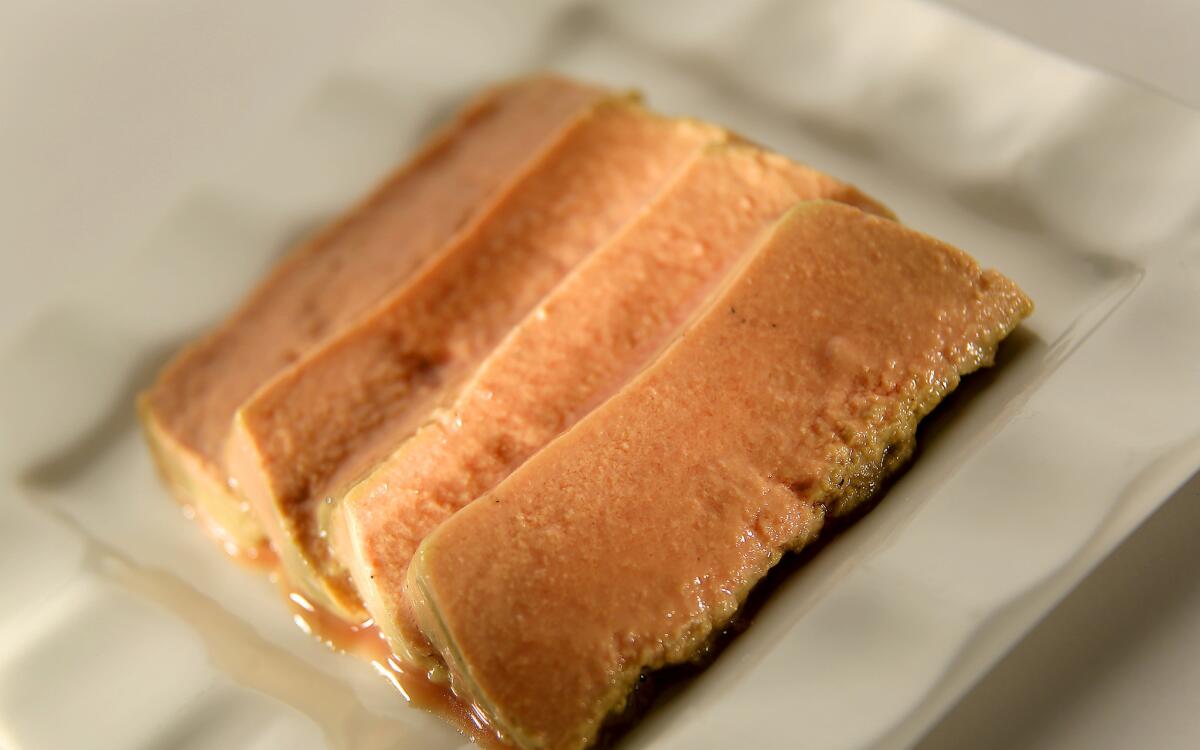Chicken liver mousse

With all the chattering about the return of foie gras to California menus, you might be tempted to think that we’ve become a state of liver lovers.
You might think that, at least, until you set out to buy some chicken livers at the supermarket. Here’s a hint: If you can find them at all, they’ll probably be in the freezer section. Demand is so low that most markets long ago gave up on offering them fresh.
But if you truly appreciate that iron bite flavor of foie gras, and not just the buttery texture or the consumption of a conspicuous luxury, you’ll find that in abundance in chicken livers.
Indeed, chef Michel Richard (“Happy in the Kitchen”) makes an utterly delicious foie gras analogue by pureeing a pound of chicken livers with two sticks of butter (you’ll find the recipe under “Faux Gras” in our California Cookbook at recipes.latimes.com).
The upside of our under appreciation of chicken livers is that they are really inexpensive. At my neighborhood market, I paid $1.29 a pound. You’ll be hard-pressed to find any other meat product priced lower than that.
This is not to suggest that chicken livers’ appeal is only to the cheap. Despite the fact that liver seems to be one of the few foods we’re still allowed to hate without criticism, chicken livers can be delicious, even though I do find that with their rich flavor they’re best appreciated in smaller portions.
But a couple of them, dusted with orange zest, wrapped in prosciutto, skewered on rosemary branches and quickly fried? Call it Tuscan rumaki if you want; I’ll have seconds.
And don’t even get me started on Richard Olney’s old-school chicken liver mousse from “Simple French Food.” It’s little more than chicken livers blended with milk and eggs and baked until set -- ridiculously luxurious for something so simple. A slice served with a tart salad of bitter greens makes a perfect light dinner.
Or saute them with pancetta and browned onions and chop them coarsely for a crostini topping as they do at AOC and Mozza. What a satisfying appetizer with a glass of wine on a cool evening.
There are a couple of tricks to cooking chicken livers. The most important, probably, is being careful not to overcook them. Sear them in a very hot pan for only a minute or two per side.
Chicken livers should be set but still rosy pink inside. Served this way, they are silky with a complex flavor. Cook them even a little too long and the texture becomes chalky and the taste more one-note bitter.
It also helps to clean them well. Older books tell you to watch for dark green spots (bile, very bitter), but in years of cooking chicken livers I don’t think I’ve ever seen this. If you do, cut it away; usually, though, you’ll just need to trim the exterior fat and any stringy connective tissue.
Another oft-repeated piece of advice is to soak chicken livers in milk before cooking them, but I’ve never read why. Curious, I sauteed a couple of unsoaked livers at the same time as ones that had been immersed in milk. I found the soaked livers seemed to have a slightly fuller, rounder flavor, so I’ll keep doing that. (If you’re starting with frozen livers, it’s a simple enough matter to defrost them in a bowl of milk.)
Are chicken livers the next foie gras? It’s unlikely, but they do have an allure all their own. And, at $1.29 a pound instead of $50 to $60 (plus shipping), that’s not chopped liver.
Cover the chicken livers with milk and set aside for at least one hour.
Heat the oven to 325 degrees and butter a 6-cup mold. Line the mold with parchment and butter again.
Purée the livers, butter, garlic, milk, whole eggs and egg yolks in a blender. Pass through a strainer into a bowl. Season with the salt and a couple of grinds of pepper.
Pour the mixture into the prepared mold and tap it lightly on a cutting board to free any trapped air bubbles. Put a folded towel in the bottom of a baking or roasting pan large enough to hold the mold. Place the mold on top of the towel and put it in the oven on the middle rack. Pour warm water into the pan up to the level of the liver mixture. If you see the water start to boil, lower the temperature and open the oven door.
Bake to an internal temperature of 155 to 160 degrees, about 1 hour and 15 minutes. The center will be slightly firm to the touch, and the edges will be just beginning to shrink from the sides. Cool completely before unmolding and slicing.
Get our Cooking newsletter.
Your roundup of inspiring recipes and kitchen tricks.
You may occasionally receive promotional content from the Los Angeles Times.















